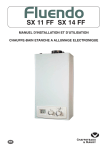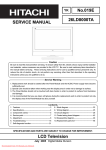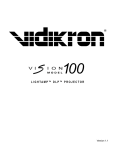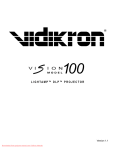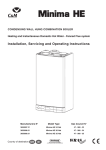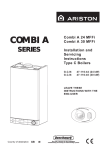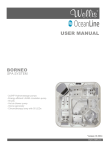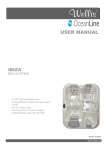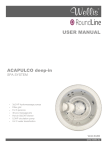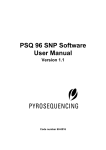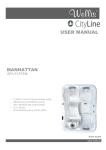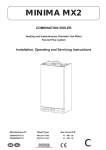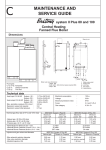Download Chaffoteaux & Maury Britony System 60 User`s manual
Transcript
BRITONY SX 14 FF INSTALLATION, SERVICING AND USER’S MANUAL Fan Flued Instantaneous Multipoint Water Heater IMPORTANT: THIS APPLIANCE IS A DOMESTIC HOT WATER APPLIANCE AND IS INTENDED FOR DOMESTIC USE ONLY Manufacturers N° 3675031 Country of destination GB IE Model Type Gas Council N° Britony SX 14 FF 52 - 980 - 25 c TABLE OF CONTENTS 1. 1.1 GENERAL INFORMATION Guarantee Page. 3 Page. 3 2. 2.1 2.2 2.3 2.4 2.5 USER INSTRUCTIONS Control Panel Initial Set-Up Use Maintenance Useful Information Page. 3 Page. 3 Page. 4 Page. 4 Page. 5 Page. 5 3. 3.1 3.2 3.3 3.4 3.5 3.6 3.7 3.8 INSTALLATION INSTRUCTIONS Page. 6 Description of Appliance Page. 6 Technical Specifications Page. 7 Operating Principle Page. 8 Electrical Circuit Diagram Page. 8 Appliance DImensions Page. 9 Clearances Page. 9 Reference Standards Page. 10 Installing the Water Heater Page. 11 4. 4.1 FITTING THE FLUE Fitting the Coaxial Flue (Ø 60/100 Horizontal) Fitting the Coaxial Flue (Ø 60/100 Vertical) Fitting the Coaxial Flue (Ø 80/125 Horizontal/Vertical) Fitting the Twin Pipe (Ø 80/80) Permissible Flue Lengths Flue Types Page. 15 Page. 16 Page. 18 Page. 18 5. COMMISSIONING Page. 19 6. SERVICING INSTRUCTIONS Page. 20 7. 7.1 7.1.1 7.2 REPLACEMENT OF PARTS To Gain General Access Removing the front panel Access to the Combustion Chamber Removing the burner box Removing the electrodes Removing the burner Removing the manifold Removing the fan Removing the air pressure switch Check the ∆P with the casing closed Acess to the Water Circuit Drain down Removing the heat exchanger Removing the water valve Access to the Control System Removing the control box Remvoing the electrical box Removing the fuse Removing the microswitch Page. 20 Page. 20 Page. 20 4.2 4.3 4.4 4.5 4.6 7.2.1 7.2.2 7.2.3 7.2.4 7.2.5 7.2.6 7.2.7 7.3 7.3.1 7.3.2 7.3.3 7.4 7.4.1 7.4.2 7.4.3 7.4.4 7.5 Access to the Gas System 7.5.1 Removing the gas valve Page. 13 Page. 13 Page. 14 Page. 21 Page. 21 Page. 21 Page. 22 Page. 22 Page. 23 Page. 23 Page. 23 Page. 24 Page. 24 Page. 24 Page. 25 Page. 26 Page. 26 Page. 26 Page. 27 Page. 27 2 Page. 28 Page. 28 8. FAULT FINDING CHART Page. 29 9. SHORT SPARES LIST Page. 31 1. GENERAL INFORMATION The Britony SX Water Heater is a room sealed, fanned flue, mulitpoint water heater. The appliance has been designed for domestic use only and to be connected to a mains cold water supply with a minimum pressure of 0.5 bar. A permanent electrical connection is required and should be provided by use of a fused spur. The electrical supply should be via a double pole isolating switch with 3mm contact separation in both poles. If the appliance is installed in a bathroom the fused spur must be located externally to the bathroom. NOTE: UNDER THE GAS SAFETY AND USE REGS 1984, IT IS THE LAW THAT ALL GAS APPLIANCES ARE INSTALLED BY A CORGI REGISTERED ENGINEER. FAILURE TO INSTALL THE APPLIANCE IN ACCORDANCE WITH ALL CURRENT REGULATIONS WILL RESULT IN THE GUARANTEE BECOMING VOID. IN HARD WATER AREAS THE USE OF A SCALE REDUCER IS RECOMMENDED. 1.1 Guarantee The guarantee on this appliance is valid for 12 months from the date of installation, provided it has been installed in accordance with this manual, with all current regulations and used solely for the purpose described in this manual. Failure to comply with this will result in the guarantee becoming void. 2. USER INSTRUCTIONS 2.1 Control Panel 2 1 3 FIG. 1 LEGEND 1 2 3 4 5 Burner power selector Water temperature selector ON-OFF switch Red LED to indicate a fault Orange LED to indicate that the equipment is in use 3 4 5 FIG. 2 2.2 Initial Set-Up IMPORTANT: The installing technician should explain to the user how the water heater works, the safety devices it includes and how to use it. Before turning the water heater on, it should be connected to the electrical mains via a double pole isolating switch with 3mm contact separation in both poles. • Make sure that gas is supplied to the water heater (valve on gas pipe open) and purge any air as necessary • Make sure that the electrical supply is turned on. 2.3 Use Obtaining hot water To turn on the water heater press the ON-OFF button (3 Fig.2). The water heater will come on automatically whenever a hot water tap is turned on. Selecting the power rating Turn the power selector (Fig. 3) to the desired power rating. The MAX position represents full power: 100%. The MIN position represents minimum power: 50%. FIG. 3 Selecting the hot water temperature Turn the water temperature selector (Fig. 4) to the desired water temperature. The MAX position represents maximum temperature (minimum flow of water through the appliance). The MIN position represents minimum temperature (maximum flow of water through the appliance). FIG. 4 Resetting the water heater In the event that the water heater locks out due to an ignition fault, the red LED (B Fig. 5) will light. Wait for at least three minutes before resetting the appliance by turning the appliance off, waiting 10 seconds and turning the appliance back on again by pressing button A, (Fig. 5). Should the appliance continue to lock out, isolate the electrical supply to the appliance at the fused spur and contact a local service agent. A B FIG. 5 IMPORTANT: This water heater is not controlled by a thermostat. The temperature of the water depends on the flow of water and the power setting. Too much flow will reduce the temperature achieved. Adjust the flow at the tap to achieve the desired temperature. Note: It is suggested that both the power rating and the temperature are adjusted to the minimum values necessary to meet your requirements. In this way energy is saved and the working life of the appliance is extended, reducing the build-up of lime scale in the heat exchanger. Stopping the water heater When you turn off the hot-water taps, the water heater stops automatically. In order to turn off the water heater, press the ON-OFF button (3 Fig. 2). 4 IMPORTANT: In the event that there is a risk of the appliance freezing, close the cold water inlet valve and drain the water heater by opening a hot water tap, see Section 2.5 Useful Information. 2.4 Maintenance Note: Before carrying out any maintenance or repair work on the appliance, the water heater MUST be disconnected from the electrical mains and the gas and water isolating valves MUST be closed. CHAFFOTEAUX & MAURY recommends that the water heater be serviced by authorised personnel once a year. The checks to be carried out are the following : • The electrical installation is in good condition (the cable is not worn, there are no deposits of oil or grease on the electrical connections, etc.); • Check the appliance for leaks of gas and water; • The combustion product ducts should be free from obstacles, correctly sealed and in good condition; • The flow of gas and the gas pressure must be within the indicated values (See 3.2); • Clean the burner and the heat exchanger. Cleaning the burner Remove the burner and clean the nozzles with a soft brush or with compressed air. Do not use chemical products (See 7.2.3); Remove the ionisation and ignition spark devices in order to clean the tips (See 7.2.2); Every 3 years the set of electrodes should be replaced. Cleaning the heat exchanger Clean the heat exchanger with hot water. If it is very dirty, leave the heat exchanger to soak in hot soapy water. Refit the heat exchanger using new washers. Cleaning the casing Clean the casing with a damp cloth (DO NOT USE ANY DETERGENTS). Preventing lime scale build-up If the appliance is installed in an area where the water is very hard, and over time it is observed that: • there is a decrease in the temperature of the hot water, or • there is a decrease in the flow of hot water this means that lime scale has built up in the body of the heater. In order to reduce this effect, we recommend that the desired water temperature is obtained by adjusting the power and gas controls and the temperature selector, and not by mixing the hot water from the heater with cold water. In hard water areas a scale reducer is recommended to reduce the likelihood of scale formation in the heat exchanger. Device for controlling the extraction of combustion products (air pressure switch). Important : The user is not permitted to tamper with the device in any way. Under no circumstances is it to be disconnected, modified or replaced by a different piece. 2.5 Useful Information During cold spells, and if the appliance is situated in a place where it is subject to freezing conditions, the water circuit in the appliance should be emptied in the following manner: Turn off the cold-water tap supplying the water heater. Turn on a hot-water tap which is fed by hot water from the water heater (this tap must be lower than the water heater itself). Open the drain screw which can be found on the water valve (See 7.3.3). 5 3 INSTALLATION INSTRUCTIONS 3.1 Description of the Appliance SX water heaters are sealed electronic water heaters, with electronic ignition and ionisation safety devices, they have a modulating burner and are connected to the mains water supply; they provide domestic hot water. Their self-contained combustion chambers with fans for the intake of external air and the extraction of combustion products, allow them to operate totally independently from the room in which they are installed. 13 12 4 3 5 7 15 6 2 1 9 10 11 8 14 FIG. 5 Main components : 1. FRAME including the bar for suspending the water heater . 2. SEALED CHAMBER BASE, which, together with the casing, forms the combustion chamber 3. PRODUCTS EXTRACTION SET which includes the extractor body, fan, air pressure switch and coaxial outlet duct Ø 60-100 4. FAN for expelling the combustion gases to the outside through the tube Ø60 and to take in air from outside the chamber 5. HEATING BODY made of copper 6. BURNER made of stainless steel and with a blue flame which works with natural gas or Butane/Propane. Distributor fitted with injectors that correspond to each type of gas 7. ELECTRODES for ignition and flame sensor which works by ionisation 8. GAS VALVE fitted with two safety valves, manual power rating selection, automatic power modulation according to the flow of water and gradual progressive lighting of the burner. 9. WATER VALVE fitted with an automatic water flow regulator and with a manual temperature selector 10. ELECTRICAL POWER SUPPLY AND CONTROL: Supplies the water heater with 1.5 V from the mains supply at 220-230 V a.c. Supplies the fan and, through the air pressure meter, controls the extraction of the combustion products. 11. ELECTRONIC CIRCUIT for igniting the flame and controlling it by means of ionisation. 12. AIR PRESSURE SWITCH which cuts off the intake of gas to the burner if waste products are not expelled correctly 13. COAXIAL OUTLET Ø 60-100 14. ELECTRICAL SUPPLY CABLE 15. HEAT EXCHANGER 6 3.2 Technical Specifications Model SX 14FF Standard, Category and Type Inspection certificate type number 0099BO814 II2H3P Category Destination country GB C12, C32, C42, C52, C82 Type Degree of protection IP44 Symbol Model Units SX 14 FF Power rating and heat consumption Nominal power output Pn 24 Minimum power output Pmin. 8.9 Power modulation range Pmin - Pn KW 8.9 - 24 Nominal heat consumption (nett) Qn 27.3 Minimum heat consumption (nett) Qmin 12 Gas specification Connection pressure 2H Natural G20 mbar 20 Gas consumption 2 H / 2E+ Natural G20 Hi=9.45 kWh/m3 m3/h 2.88 Burner pressure at nominal power 2 H / 2E+ Natural G20 mbar 11.5 ∆ 50°C l/min 2.3 - 7 ∆ 25°C l/min 3.7 - 14 Hot-water specification Flow rate of the water Max. working pressure Min. working pressure bar 10 Max. Temp. selector bar 0.5 Min. Temp. selector bar 0.5 Combustion products °C Temperature 196 196 Electrical details Electrical power supply V/Hz 220-230V - 50Hz Maximum intake power W 55 Dimensions of connections and diameters of the tubes Connections/Ø inside (mm) Gas intake 1/2”/Ø 15mm Cold Water Inlet 1/2”/Ø 15mm Hot Water Outlet 1/2”/Ø 15mm Flue outlet (mm) Flue Length Ø 60 - 100 mm Ø 60/100 Horizontal Maximum 3 metres Minimum 0.37 metres Ø 60/100 Vertical Maximum 4 metres Minimum 1.5 metres Ø 80/125 Horizontal Maximum 6 metres Minimum 0.37 metres Ø 80/125 Horizontal Maximum 6 metres Minimum 1.5 metres 7 3.3 Operating Principle 1.- Gas inlet 2.- Cold water inlet 3.- Gas filter 4.- Lower body 5.- Upper body 6.- Water regulator 7.- Test nipple 8.- Water filter 9.- Power selector 10.- Solenoid-valve 11.- Injector 12.- Distributor 13.- Main body 14.- Electrode set 15.- Power supply circuit and control of extraction 16.- Burner 17.- Heating body 18.- Fan assembly 19.- Air pressure switch 20.- Ignition box and ionisation safety unit 21.- Microswitch 22.- Distributor connector 23.- Combustion chamber 24.- Flue Connection Ø60-100 25.- Electrical supply cable 24 18 23 19 15 17 16 14 12 20 11 22 7 6 13 25 21 3 1 10 2 8 4 9 FIG. 6 5 3.4 Electrical Circuit Diagram 8 1 4 9 10 3 1.- ON/OFF Switch 2.- Supply connector 3.- Solenoid-valve 4.- Microswitch 5.- Power supply circuit and control of extraction 6.- Air pressure switch 7.- Fan 8.- Ionisation electrode 9.- Confirmation electrode 10.- Spark electrode 11.- Red LED to indicate a fault 12.- Burner operation indicator (LED) 2 Rele(Blanco) G (Negro) Presostato aire(Rojo) Rele(Blanco) Transparente Transparente Presostato aire(Rojo) 7 V-(Negro) Rojo V+(Rojo) 5 SW (Naranja) SW (Naranja) SV (Verde) 11 12 6 FIG. 7 8 3.5 Appliance Dimensions Agujero Hole ø 110 G F W Tubo ø 100 Tube E X L B O H Q P M N MODEL 14 litres C D A FIG. 8 Dimensions (mm) Weight (kg) A B C D E F G H L M N O P Q W X 16 330 595 230 247 60/100 34 122 230 513 50 61.5 592 75 14.5 138 143 3.6 Clearances FIG. 9 9 3.7 Reference Standards In the United Kingdom, the installation and initial start up of the water heater must be by a CORGI Registered installer in accordance with the installation standards curently in effect, as well as with any and all local health and safety standards i.e. CORGI. Q Q I Q D,E F In the Republic of Ireland the installation and initial start up of the appliance must be carried out by a Competent Person in accordance with the current edition of I.S.813 “Domestic Gas Installations” and the current Building Regulations, reference should also be made the the current ETCI rules for electrical installation. J B G A I The installation of this appliance must be in accordance with the relevant requirements of the Local Building Regulations, the current I.E.E. Wiring Regulations, the bylaws of the local water authority. In Scotland, in accordance with the Building Standards (Scotland) Regulation and Health and Safety document No. 635, “Elelectricity at Work Regulations 1989” and in the Republic of Ireland with the current edition of I.S. 813 and the Local Building Regulations (IE). N C L M N H H M K FIG. 10 The minimum acceptable clearances are shown below: - A Directly below an opening, window, etc 300 mm 300 mm - B Above an opening, window, etc - C Horizontally to an opening, window, etc 300 mm - D Below gutters, soils pipes or drain pipes 75 mm - E Below eaves 200 mm 200 mm - F Below balconies or car port roof - G From a vertical drain pipe or soil pipe 150 mm - H From an internal or external corner 300 mm - I Above ground roof or balcony level 300 mm - J From a surface facing the terminal 600 mm - K From a terminal facing the terminal 1200 mm - L From an opening in the car port into the dwelling 1200 mm - M Vertically from a terminal on the same wall 1500 mm - N Horizontally from a terminal on the same wall 300 mm - Q Fixed by flue terminal C.O.S.H.H. Materials used in the manufacture of this appliance are nonhazardous and no special precautions are required when servicing. Codes of Practice Installation should also comply with the following British Standards Codes of Practice: BS 5546:1990 Installation of hot water supplies for domestic purposes BS 5440-1:2000 Flues BS 5440-2:2000 Air Supply BS 6891:1989 Installation of low pressure gas pipe up to 28mm IEE Wiring Regulations BS 7671:2001 BS 5482:1994 Installation of L.P.G. Installation of gas-fired hot water BS 6798:1987 boilers of rated input not exceeding 60 kW NOTE: THE It may be necessary to protect the terminal with a guard. Reference should be made to the Building Regulations for guidance. and in the Republic of Ireland in accordance with the following codes of practice: I.S. 813 FLUE MUST NOT BE INSTALLED IN A PLACE LIKELY TO CAUSE A NUISANCE. Domestic Gas Installations Flue Detailed information on flue assembly can be found in Section 4 “Fitting the Flue”. The appliance must be installed so that the flue terminal is exposed to the free passage of external air at all times and must not be installed in a place likely to cause nuisance. It must not be allowed to discharge into another room or space such as an outhouse or closed lean-to. The terminal should be located with due regard for the damage or discolouration that might occur to buildings in the vicinity and consideration must also be given to adjacent boundaries. In cold or humid weather, water vapour may condense on leaving the flue terminal. The effect of such “pluming” must be considered. 10 3.8 Installing the Water Heater The appliance must be provided with a means of isolation. If installed in a bathroom, the means of isolation must be external to the bathroom or a double pole cord switch fitted. The following elements are supplied with the heater : 1x 1x 1x 1x 1x Cold water inlet pipe Cold water inlet tap Flexible hot-water outlet tube Twin flue air inlet adaptor Gas inlet tap 2x 2x 1x 1x Plastic wall plugs Screw hooks Gas inlet pipe Restrictor Assorted washers Acceptable methods of connection are: • A switched double pole fused spur with 3mm contact separation on all poles. The dimensions for installing the appliance are detailed in Sections 3.5 and 3.6 (page 9). • A double pole switch where the supply must be suitably fused 3A. Siting the Appliance • An unswitched socket outlet complying with BS 1363. The location chosen for the appliance must permit the provision of a satisfactory flue termination (see Fig. 10, Section 3.7). The location must also permit adequate space for servicing and air circulation around the appliance (see Fig. 9, Section 3.6). The appliance may be installed in any room or internal space, although particular attention is drawn to the current requirements of the current edition of BS7671, in Scotland, the electrical provisions of the Building Standards applicable in Scotland, and in Ireland in line with the electrical provisions of I.S. 813, with respect to the installation of a heater in a room or internal space containing a bath or shower. A three core cable should be used and a heat resistant cable of 0.75 mm2 (24 x 0.2 mm) is considered suitable. Removing the Outer Case Remove the gas and water control knobs; Loosen the screw behind the control knob that secures the outer case; Release the two locks on the top of the casing and remove the case (See also Section 7.1.1, page 20). Where a room sealed appliance is installed in a room containing a bath or shower, any electrical switch or appliance control using main electricity should be situated so that it cannot be touched by a person using the bath or shower. Wall Mounting Where the installation of the appliance will be in an unusual location, special procedures may be necessary, the current edition of BS 5546 should be consulted. Connecting the Heater to the Water and Gas Supplies Fix the two screw-in hooks to the wall and hang the water heater on them. In the event that the appliance is to be installed in a timber framed building, it should be fitted in accordance with the British Gas Document ‘Guide for Gas Installations in Timber Framed Housing’ reference DM2. If in doubt, advice must be sought from British Gas. Before connecting up the appliance it is necessary to thoroughly flush and purge the water and gas pipes in order to remove filings or other waste from them; Connect the water heater using the corresponding washers and connectors which are supplied in the bag of accessories; Place the casing back on and secure it in place; Replace the gas knob and the temperature selector knob; Gas Supply Sealing the Water Circuit An adequate sized gas meter must be connected to the service pipe. Where necessary the local gas supplier will arrange for the existing meter to be checked or for a suitable meter to be fitted. Installation pipes should be fitted in accordance with BS 6891. Pipework from the meter must be of adequate size. Pipes of a smaller size than the gas connection must not be used. The complete installation must be tested for gas soundness and purged in accordance with the current edition of BS 6891. Open the water inlet tap into the appliance by turning the water inlet tap on the heater fully on. Bleed any air from the water pipes by opening all the taps: hot and cold. Then turn off all the taps and check for watertightness. Air Supply Connecting the Water Heater to the Electrical Mains The appliance does not require any purpose provided ventilation. The water heater is fitted with an electrical supply cable for a 220-230V~50Hz mains supply. It is to be connected to a singlephase power supply with an earth. In order to protect the heater it is necessary to have a bipolar switch with a minimum opening distance of 3 mm. Sealing the Gas Circuit IMPORTANT! Test for soundness in accordance with current regulations. Electrical Supply The appliance must be earthed. IMPORTANT : Whenever carrying out an operation on the electrical installation of the heater, make sure that the heater is disconnected from the mains power supply The new power cable is to have the same specifications as the one originally installed in the heater. The means to isolate the power supply should be easily accessible. The installation must be undertaken by a competent electrician and should be in accordance with the current edition of BS 7671. Particular attention should be paid to cross bonding. 11 3.8 Installing the Water Heater Purging the Gas Supply Once all the above checks are complete, it will be necessary to purge the gas supply of air. Do not under any circumstances attempt to purge the gas pipe of air by continually pressing the On/Off button to reset. If it is necessary to do this, you must wait at least three minutes between each press of the On/Off button. Completion Once installation is complete, commission the appliance as instucted in Section 5, page 19). Instruct the end user on the following: • How to switch off the appliance quickly and indicate the position of the electrical supply isolator. • Explain to the end user that if the appliance is not to be used for long periods that it is advisable to drain the appliance to prevent damage in the event of it freezing. • Advise the end user that to ensure safe and effective operation, the appliance must be serviced once a year by a CORGI registered gas engineer. • Finally, leave these instructions with the end user. 12 4. FITTING THE FLUE The water heater must only be installed with a flue supplied by the manufacturer. These kits are supplied separately to the appliance in order to respond to different installation solutions. For more information with regard to the inlet/outlet accessories consult the flue brochure and the following instructions. The water heater is supplied ready for connection to a concentric gas intake and exhaust duct system. WARNING!! The exhaust gas ducts should not be in contact with or close to inflammable material and should not pass through building structures or walls made of inflammable material. When replacing an old appliance, the flue must be changed. IMPORTANT!! Ensure that the flue is not blocked. Ensure that the exhaust gas ducts do not have leaks Ø 60/100 mm Fig. 11 4.1 Fitting the Coaxial Flue (Ø 60/100 Horizontal) CONTENTS: 1X SILICONE O-RING (60mm) 1X ELBOW (90 ) 2X WALL SEALS (INTERNAL & EXTERNAL) 1X FLUE PIPE INCLUDING TERMINAL (1 METRE - 60/100) 2X FLUE CLAMPS 4X SCREWS 2x Seals Once the water heater has been positioned on the wall, insert the elbow into the socket and rotate to the required position. NOTE: It is possible to rotate the elbow 360o on its vertical axis. O If necessary, fit the restrictor ring (see Fig. 12 and Table on Page 18). Coaxial Using the flue clamp, seals and screws supplied (Figs. 11 & 13) secure the elbow to the boiler. The 1 metre horizontal flue kit (3318000) supplied is suitable for an exact X dimension of 823 mm. Fig 12 WARNING!! Consult the table on Page 18, to see if a restrictor is required for the type of flue system being used. Should it be necessary to fit the restrictor, it must be fitted as shown in Fig. 12. Measure the distance from the face of the external wall to the face of the flue elbow (X - Fig 11), subtract 48 mm from this measurement, you now have the total length of flue required (including the terminal), this figure must now be subtracted from 907mm, you now have the total amount to be cut from the plain end of the flue. Cut the flue to the required length ensuring that the distance between the inner and the outer flue is maintained (Fig 14). 13 4.1 Fitting the Coaxial Flue (Ø 60/100 Horizontal) Continued/...... Clamp e.g. X = 508mm - 48mm = 460mm 823 - 460 = 363mm (Length to be cut from the plain end of the flue). Ensure that the inner flue is 23mm longer than the outer flue. See Fig. 14. Once cut to the required length, ensure that the flue is free from burrs and reassemble the flue. If fitting the flue from inside of the building attach the grey outer wall seal to the flue terminal and push the flue through the hole, once the wall seal has passed through the hole, pull the flue back until the seal is flush with the wall. Alternatively, the flue can be installed from outside of the building, the grey outer seal being fitted last. Should the flue require extending, the flue connections are push fit, however, one flue bracket should be used to secure each metre of flue. Screws Seal 23 mm FIG. 13 L L 23 mm 1 1 2 2 m m 23 FIG. 14 4.2 Fitting the Coaxial Flue (Ø 60/100 Vertical) NOTE: SEE PAGE 18 FOR MAXIMUM AND MINIMUM FLUE RUNS. CONTENTS: 1X SILICONE O-RING (60mm) 1X CONICAL ADAPTOR (60/100mm) 1X VERTICAL FLUE KIT (80/125mm) 3X SCREWS The vertical flue kit is supplied with a specially designed weather proof terminal fitted, it can be used either with a flat roof or a pitched roof. The Vertical flue kits useable lengths with the pitched roof flashings are indicated in Fig. 15. Before proceeding to fit the flue, ensure that the maximum flue length has not been exceeded (See the tables on Page 18) and that all elbows and bends have been taken into consideration, the maximum flue length is 4 metres, for each additional 90o elbow 1 metre must be subtracted from the total flue length, and for each 45o 0.5 metres must be subtracted from the total flue length (the height of the vertical adaptor and a 45o bend can be seen in Fig. 16). Fig. 15 Mark the position of the flue hole in the ceiling and/or roof (see Fig. 15 for distance from wall to the centre of the flue). Cut a 120mm diameter hole through the ceiling and/or roof and fit the flashing plate to the roof. 14 4.2 Fitting the Coaxial Flue (Ø 60/100 Vertical) Continued/...... DO NOT cut the vertical flue kit. To connect the vertical flue kit directly to the boiler, place the vertical starter kit (Part No. 3318008) (see Fig. 15) onto the exhaust manifold and secure with the clamp, fit the Ø125/100 adaptor onto the vertical starter kit (note: there is no need to use a clamp to secure this as it is a push fit connection), the vertical flue kit must then be inserted through the roof flashing from the outside, this will ensure that the correct clearance above the roof is provided as the terminal is a fixed height. Should extensions be required, they are available in 1 metre (Part No. 3318005), 500mm (Part No. 3318006) and 250mm lengths (Part No. 3318007), they must be connected directly to the vertical starter kit before connecting the adaptor to allow the vertical flue kit to be fitted. In the event that extension pieces need to be shortened, they must only be cut at the male end and it must be ensured that the distance between the inner and outer flue is maintained (Fig. 14). When utilising the vertical flue system, action must be taken to ensure that the flue is supported adequately to prevent the weight being transferred to the appliance flue connection by using 1 flue bracket per extension. Fig. 16 When the flue passes through a ceiling or wooden floor, there must be an air gap of 25mm between any part of the flue system and any combustible material. The use of a ceiling plate will facilitate this. Also when the flue passes from one room to another a fire stop must be fitted to prevent the passage of smoke or fire, irrespective of the structural material through which the flue passes. 4.3 Fitting the Coaxial Flue (Ø 80/125 Horizontal / Vertical) NOTE: SEE PAGE 18 FOR MAXIMUM AND MINIMUM FLUE RUNS. Once the boiler has been positioned on the wall, for horizontal flue runs, insert the Ø60/100 elbow onto the boiler, and connect the elbow to the Ø80/125 adaptor, for vertical flue runs it is necessary to insert the Ø80/125 adaptor (FIG. 17) (not supplied with flue kit - Part No 3318040) into the boiler flue socket. Push the adaptor onto the boilers flue connection, grease the seals then add extensions or elbows as required, secure the adaptor, using the clamp and screws provided. To fit extensions or elbows it is first necessary to ensure that the lip seal is fitted correctly into the inner flue, once verified, it is simply necessary to push them together, no clamps are necessary to secure the flue components. FIG. 17 Before proceeding to fit the flue, ensure that the maximum flue length has not been exceeded (See the tables on Page 18) and that all elbows and bends have been taken into consideration, the maximum flue length is 6 metres, for each additional 90o elbow 1 metre must be subtracted from the total flue length, and for each 45o 0.5 metres must be subtracted from the total flue length (the height of the vertical adaptor and a 45o bend can be seen in Fig. 18 and a 90o bend in Fig. 19). NOTE: DO NOT 15 CUT THE VERTICAL FLUE KIT. 4.3 Fitting the Coaxial Flue (Ø 60/100 Vertical) Continued/....... FIG. 18 FIG. 19 4.4 Fitting the Twin Pipe (Ø 80/80) NOTE: SEE PAGE 18 FOR MAXIMUM AND MINIMUM FLUE RUNS. Where it is not possible to terminate the flue within the distance permitted for coaxial flues, the twin flue pipe can be used by fitting a special adaptor to the flue connector and using the aperture for the air intake located on top of the combustion chamber. WARNING!! Consult the table on Page 18, to see if a restrictor is required for the type of flue system being used. Should it be necessary to fit the restrictor, it must be fitted as illustrated in Fig. 20. Always ensure that the flue is adequately supported, avoiding low points. (MTS supply suitable clamps as Part No. 3318015). To utilise the air intake it is necessary to: 1) Take the air intake cover off 2) Assemble the flange on the header supplied with the appliance 3) Insert the restrictor if necessary, between the tube and the elbow 4) Insert the header on the tube or the elbow up until the lower stop (you do not have to use a washer). 5) Insert the elbow/header in the boiler air intake hole and fasten it with screws. Fig. 20 The twin flue pipes can be fitted with or without additional elbows and need no clamps, simply ensure that the red oring is inserted in the female end of the flue pipe and push the extension piece fully into the previous section of flue pipe or elbow, check that the o-ring is not dislodged when assembling the flue. Twin flue Twin pipe can also be converted back to Coaxial flue to enable vertical termination with a coaxial kit by using the pipe bridge (Twin - Coaxial Adaptor - Part No. 3318033). When running the twin flue pipe vertically. 16 4.4 Fitting the Twin Pipe (Ø 80/80) Continued/....... 122 200 230 MIN * 132 123,5 When siting the twin flue pipe, the air intake and exhaust terminals must terminate on the same wall, the centres of the terminals must be a minimum of 280 mm apart and the air intake must not be sited above the exhaust terminal (refer to Fig. 23). The air intake pipe can be run horizontally, however, the terminal and the final 1 metre of flue must be installed with a fall away from the boiler to avoid rain ingress. It is also strongly recommended that the air intake pipe run be constructed of insulated pipe to prevent condense forming on the outside of the tube. Fig. 21 The maximum permissible flue length for twin flue is dependent on the type of run used. For flue runs with the intake and exhaust pipes under the same atmospheric conditions (TYPE 4) the maximum length is 10 metres (5 metres for the air intake and 5 metres for the exhaust), for runs with the terminals under different atmospheric conditions (TYPE 5) the exhaust terminal must extend 0.5 metres above the ridge of the roof (this is not obligatory if the exhaust and air intake pipes are located on the same side of the building). For TYPE 5 also, the maximum permissible combined length is 10 metres (5 metres for the air intake and 5 metres for the exhaust). In the event that twin flue pipes are used, and the water heater has a side clearance of less than 60mm from the wall, it is necessary to cut a larger diameter hole for the flue pipe, this should be ø10 cm, this will then allow for easier assembly of the air intake elbow and the tube outside the wall (see Fig. 22). ø 100 The maximum length is reached by combining the total lengths of both the air intake and exhaust pipes. Therefore a maximum length of 10 metres for example, will allow a flue run of 5 metres for the air intake and 5 metres for the o exhaust pipes, also for each 90 elbow 2.2 metres must be subtracted from the total length and for each 45o elbow 1.4 metres must be subtracted from the total flue length. Some of the acceptable flue configurations are detailed on page 18. 60 mm For further information relating to flue runs not illustrated, please contact the Technical Department on 0870 241 8180. FIG. 22 AIR INTAKE MUST NOT BE FITTED ABOVE THE EXHAUST AIR INTAKE EXHAUST AIR INTAKE FIG. 23 17 4.5 Permissible Flue Lengths SX 14 FF Exhaust Type Type 1 Coaxial Systems ø 60/100 Type 2 Type 3 Type 1 Coaxial Systems ø 80/125 SX 14 FF Twin Pipe Systems ø 80/80 Type 2 Use the ø 85 mm Restrictor Between 0.3 m / 1 m Between 0 m / 1.5 m Between 0 m / 1.5 m Between 0.3 m - 2 m Between 0m-2m Do not use the Maximum Flue Reduction for Reduction for Restrictor Length 90o Bend 45o Bend 1m-3m 3m 1m 0.5 m 1.5 m - 4 m 4m 1m 0.5 m 1.5 m - 4 m 4m 1m 0.5 m 2m-6m 6m 1m 0.5 m 2m-6m 6m 1m 0.5 m 2m-6m 6m 1m 0.5 m Type 3 Between 0m-2m Exhaust Type Use the ø ?? mm Restrictor Type 4 Between 0m-3m Between 3 m - 10 m 10 m 1.4 m 2m Type 5 Between 0m-3m Between 3 m - 10 m 10 m 1.4 m 2m Do not use Maximum the Restrictor Flue Length Reduction for Reduction for 90o Bend 45o Bend The Ø 85 diaphragm is included in the accessories kit with the SX 14FF model. 4.6 Flue Types TYPE 1 TYPE 2 TYPE 5 TYPE 4 NOTE: DRAWINGS ARE INDICATIVE OF FLUEING OPTIONS ONLY. 18 TYPE 3 Fig. 24 5. Comissioning Once the water heater installation has been completed, it is necessary to commision the appliance as follows: Gas supply installation Inspect the entire installation including the meter, test for soundness and purge, as described in BS 6891. Checking electricity supply Carry out preliminary checks for earth continuity, polarity, resistance to earth and short circuit. Leave the appliance with the front cover fitted and the mains electrical supply isolated. Fig. 25 Lighting the boiler Ensure that the gas and water service valves below the appliance are open; Ensure that the gas supply is properly purged as BS 6891; Open a hot water tap and ensure that all air is purged from the appliance and the pipes; Switch on the mains electrical supply, and turn the appliance on at the On/Off switch; Turn on a hot water tap; The appliance will attempt to ignite, should this fail due to air in the gas pipe, the appliance will lock-out, it will be neccessary to reset the appliance as explained in Section 2.3 (page 4). Fig. 26 Setting the gas pressures Connect a manometer to the test nipple on the gas section (1, Fig. 25) and check for adequate standing pressure. Turn on the hot water tap nearest to the water heater and ensure that the working pressure is that shown in Table A. Once the working pressure has been established, check that the burner pressure is that indicated in Table A. To check the burner pressure, it is necessary to connect a manometer to the test nipple (2. Fig. 26), should the burner pressure require adjusting, use the screw (3, Fig. 27) to adjust, turn clockwise to increase the pressure and anti-clockwise to decrease the pressure. NOTE: THIS APPLIANCE IS NOT SUITABLE FOR CONVERTING FROM ONE GAS GROUP TO ANOTHER, IT IS RECOMMENDED THAT THE CORRECT WATER HEATER BE ORDERED TO MATCH THE TYPE OF GAS BEING USED. Fig. 27 TABLE A Working Pressure Natural 20 mbar Burner Pressure Natural 12.7 mbar 19 6. SERVICING INSTRUCTIONS A To ensure efficient safe operation, it is recommended that the water heater is serviced annually by a competent person. Before starting any servicing work, ensure both the gas and electrical supplies to the water heater are isolated and the water heater is cool. Before and after servicing, a combustion analysis should be made via the flue sampling point. After servicing, preliminary electrical system checks must be carried out to ensure electrical safety (i.e. polarity, earth continuity, resistance to earth and short circuit). FIG. 28 7. REPLACEMENT OF PARTS FIG. 29 The life of individual components vary and they will need servicing or replacing as and when faults develop. The fault finding sequence chart in Section 8 will help to locate which component is the cause of any malfunction, and instructions for removal, inspection and replacement of the individual parts are given in the following pages. 7.1 To Gain General Access All testing and maintenance operations on the water heater require the removal of the casing. 7.1.1 Removing the front panel : 1. Unlock the two clamps locking A (see Figs. 28); 2. Remove the control knobs and the screw below (see Fig. 29). 3. Remove the front panel from the rest of the casing (see Fig. 30). FIG. 30 20 7.2 Access to the Combustion Chamber 7.2.1 Removing the burner box 1. Carry out step 7.1.1; 2. Remove the two clips, one on either side of the burner box (Fig. 31 & 32); 4. Pull the burner box towards you (Fig. 33). 5. Reassemble in reverse order. B B FIG. 32 FIG. 33 3. Remove the screw C from the manifold (Fig. 35); 4. Pull the electrodes towards you (Fig. 36). 5. Reassemble in reverse order. FIG. 31 7.2.2 Removing the electrodes 1. Carry out step 7.1.1 and 7.2.1; 2. Disconnect the electrodes wire (Fig. 34); C FIG. 34 FIG. 35 21 FIG. 36 7.2.3 Removing the burner 1. Carry out step 7.1.1 and 7.2.1; 2. Disconnect the electrodes wire (Fig. 37); 3. Remove the 2 screws D from the combustion chamber (Fig. 38); 4. Remove the 2 screws E between the elbow and the gas valve (Fig. 39); D E FIG. 37 FIG. 38 FIG. 39 5. Remove the 2 screws F fixing the burner to the combustion chamber (Fig. 40). 6. Pull the burner towards you (Fig. 41); 7. Remove the screws G, H, I to free the burner from the gas elbow, the electrodes and the manifold (Fig. 42); 8. Reassemble in reverse order G H I F FIG. 40 FIG. 42 FIG. 41 7.2.4 Removing the manifold 1. Carry out step 7.1.1 and 7.2.1; 2. Remove the burner as in step 7.2.3; 3. Remove the 2 screws I between the burner and the manifold (Fig. 43); 4. Remove the 3 screws G & H to free the manifold from the gas elbow and the electrodes (Fig. 44); 5. Reassemble in reverse order. G G H H I FIG. 44 FIG. 43 22 7.2.5 Removing the fan 1. Carry out step 7.1.1; 2. Remove the fan wires (Fig. 45); 3. Remove air pressure switch connections K (noting position Fig. 43); 4. Remove the screws J & L to free the fan (Fig. 45, 46, 47 & 48); K L K 4. Pull the fan towards you (Fig. 49); 5. Reassemble in reverse order. J FIG. 47 FIG. 46 L L FIG. 49 FIG. 48 FIG. 45 7.2.6 Removing the air pressure switch 1. Carry out step 7.1.1; 2. Remove the wires M and air pressure switch pipes N noting position (Fig. 50); M 3. Remove the two screws O (Fig. 51 & 52); 4. Reassemble in reverse order N O FIG. 52 FIG. 50 FIG. 51 7.2.7 Check the ∆P with casing closed 1. Remove the protection cap at the top of the appliance (Fig. 53); 2. Connect the manometer and measure the ∆P (Fig. 54); 3. Ensure that the cap is replaced after measurement. FIG. 53 FIG. 54 23 7.3 Access to the Water Circuit Important! Before any component is removed, the water heater must be drained of all water. 7.3.1 Drain down 1. 2. 3. 4. 5. Carry out step 7.1.1; Turn OFF the cold water inlet tap on the appliance; Place a container under screw P (Fig. 55) to catch any water; Remove the screw P on the water valve (Fig. 55 & 56); Turn ON the hot water outlet tap. P FIG. 55 FIG. 56 7.3.2 Removing the heat exchanger 1. Carry out steps 7.1.1 & 7.3.1; 2. Free the air pressure switch wires from the heat exchanger by removing the clip (Fig. 57); 3. Unscrew the nut on the exchanger hot water outlet (Fig. 58); 4. Unscrew the nut on the exchanger water inlet (Fig. 59); FIG. 57 FIG. 58 FIG. 59 5. Remove the two clips between the heat exchanger and the top of the combustion chamber (Fig. 60 & 61); 6. Pull the exchanger towards you (Fig. 62); 7. Reassemble in reverse order. FIG. 60 FIG. 61 24 FIG. 62 7.3.3 Removing the water valve 1. Carry out step 7.1.1; 2. Drain the water heater as in step 7.3.1 by removing the screw P (Fig. 63) after turning OFF the water inlet tap and turning ON the water outlet tap; 3. Remove the nut between the water valve and the heat exchanger (Fig. 64); P FIG. 64 FIG. 63 4. Remove the two screws Q (Fig 65 & 66); 5. Pull the water valve toward the right (Fig. 67); 6. Reassemble in reverse order. Q Q FIG. 65 FIG. 66 25 FIG. 67 7.4 Access to the Control System 7.4.1 Removing the control box 1. Carry out step 7.1.1; 2. Disconnect the electrodes wires (Fig. 68); 3. Remove the gas valve wires (Fig. 69); 4. Remove the screws R1 & R2 and pull the control box towards you (Fig. 70) 5. Reassemble in reverse order. R1 R2 FIG. 68 FIG. 69 Fig. 70 3. Remove connections on the control box (Fig. 73); 4. Remove the screw R1 to free the earth connections (Fig. 74); 7.4.2 Removing the electrical box 1. Carry out step 7.1.1; 2. Disconnect the fan and air pressure switch wires (Fig. 71 & 72); R1 FIG. 71 FIG. 72 FIG. 73 5. Remove the two screws R3 below the appliance and pull the control box towards you (Fig. 75 & 76) 6. Reassemble in reverse order. R3 R3 FIG. 75 FIG. 76 26 FIG. 74 7.4.3 Removing the fuse 1. Carry out step 7.1.1; 2. Remove the five screws S on the electrical box (Fig. 77); 3. Remove electrical box cover (Fig. 78); 4. Remove the fuse (Fig. 79); 5. Reassemble in reverse order. S FIG. 77 FIG. 78 FIG. 79 3. Remove the two screws T (Fig. 81); 4. Pull the microswitch down (Fig. 82); 5. Reassemble in reverse order. 7.4.4 Removing the microswitch 1. Carry out step 7.1.1; 2. Disconnect the microswitch (Fig. 80); T FIG. 80 FIG. 81 27 FIG. 82 7.5 Access to the Gas System 7.5.1 Removing the gas valve 1. Carry out steps 7.1.1 & 7.3.1; 2. Remove the microswitch as in step 7.4.4 (Fig. 83); 3. Disconnect the gas valve (Fig. 84); FIG. 85 FIG. 84 FIG. 83 5. Remove the 2 screws U between the electrical box and the gas valve (Fig. 86); 4. Remove the water valve as in step 7.3.3 (Fig. 85); 6. Remove the 2 screws E between the elbow and the gas valve (Fig. 87); 7. Remove the 2 screws V securing the gas valve on the chassis (Fig. 88); U V E FIG. 87 FIG. 86 28 FIG. 88 8. FAULT FINDING CHART PRELIMARY CHECKS MAKE SURE THAT: 1 - The mains water supply is turned on 2 - The gas is turned on 3 - The electrical supply is turned on PRESS THE ON/OFF BUTTON DRAW OF WATER > 2.3 L/min HAS THE MICROSWITCH CLOSED? NO POWER TO MICROSWITCH? YES NO 1 - Check/replace connection cable 2 - Check/replace water group diaphragm 3 - Check/replace the printed circuit board YES 1 - Replace microswitch HAS THE FAN STARTED TO RUN? NO MOMENTARY POWER TO FAN ? YES NO 1 - Check/replace connection cable 2 - Check/replace control box 3 - Check/replace electrical box YES 1 - Replace fan HAS THE IGNITION SEQUENCE BEGUN ? NO YES IS FAN RUNNING CONTINUOUSLY? YES IS SPARK GENERATION NORMAL ? 1 - Check air pressure switch 2 - Check venturi & pipes 3 - Check fan efficiency NO 1 - Check ignition electrode cable 2 - Check/replace ignition electrode 3 - Check/replace control box 4 - Check/replace electrical box NO 1 - Check power supply of gas valve 2 - Check efficiency of gas valve 3 - Replace gas valve 4 - Check/replace control box 5 - Check/replace electrical box YES IS THE BURNER ALIGHT ? YES HAS THE BOILER SAFETY SHUTDOWN BEEN ACTIVATED ? 1 - Check if flame strikes detection electrode 2 - Check soft-light gas pressure 3 - Check/replace detection electrode 4 - Check/replace control box 5 - Check/replace electrical box YES NO A FC P010a 29 A IS THERE STILL A PROBLEM? FAULTS YES POSSIBLE CAUSES 1 Drawing D.H.W: - check gas pressures - check water flow rate - check heat exchanger insufficient hot water temperature NO 2 Drawing D.H.W: noisy operation - heat exchanger faulty or lime-scale deposits - low heating system water pressure - check gas pressures Repeated shutdowns - faulty detection electrodes - check gas settings - check flame detection electric circuit When cold water tap turned off, the water heater ignites - drop in pressure in the water mains, with consequent water hammer NORMAL OPERATION 3 4 FC P011 30 9. SHORT SPARES LIST SHORT LIST 702 103 206 102 216 901 607 601 632 636 616 631 631 633 Description G.C N° Manf. Pt. N° Type FF 100 102 103 200 206 FRONT CASE KNOB FACIA FAN ASSEMBLY FAN ASSY FAN ASSY 216 AIR PRESSURE SWITCH AIR PRESSURE SWITCH 600 601 61400288 61400289 61400261 61401861 61400262 61401809 GAS SECTION GAS SECTION NAT ASSY GAS SECTION NAT ASSY 607 616 631 632 633 634 635 636 IGNITION ELECTRODE 700 702 WATER SECTION ASSY 900 901 JIG PLATE & PIPE FITTING MICRO SWITCH BOX CABLE CABLE ELECTRICAL BOX CONTROL BOX FUSE 250V 0.5A - TEMPORIZED CABLE DIAPHRAGM CONNECTION KIT 61400270 61401802 61400271 61400272 61400274 61400298 61400276 61400275 61400290 61400299 61400278 61401808 NAT NAT .. . .. .. .. .. .. . . . . . . . . . . . . .. .. .. 31 Manf. date from to 03/05 Key N° FL U EN DO 14 635 634 AND CONDITIONS Please read these terms and conditions which are in addition to any terms and conditions detailed in this book or any registration card supplied with your appliance. A charge will be made to the owner of the appliance if: ∑ ∑ ∑ ∑ The reason for any service visit is as a direct result of a failure to install the appliance in accordance with the manufacturer’s instructions. Your installer does not complete the necessary commissioning process and procedure as detailed in the Installation and Operating Instructions. Your appliance is not serviced on or before the 12 month anniversary of installation - this only applies to appliances with a 2 and 5 year guarantee. Our service engineer calls as requested and the failure is a non-manufacturing defect. Failure to pay an invoice for any such occurence will be assumed by MTS that you accept that your appliance has not been installed correctly and understand that any manufacturer’s guarantee has been withdrawn. OF GUARANTEE On the 12 month anniversary of the appliance installation, you must have it serviced to continue any guarantee offered into the following year. Failure to do so will invalidate your guarantee and should an MTS engineer be required to attend and no proof of service documentation is made available, then MTS will charge. As part of the commissioning process, it is a legal requirement to register all installations or replacements with CORGI. Upon registration a “Certification Number” will be issued followed by a “Declaration of Safety” Certificate. MTS (GB) Ltd cannot be called upon to carry out any work under the manufacturer’s guarantee without proof of registration. The registration number must be quoted when requesting a service visit, and the “Declaration of Safety” Certficate subsequently shown to the service engineer. If the certificate is not made available, the engineer will not work on the appliance and a wasted call charge will be made. If you have a problem with commissioning on installation, please contact our Technical Department on 0870 241 8180 Manufacturer: Chaffoteaux & Maury - France Commercial subsidiary: MTS (GB) Limited, MTS Building, Hughenden Avenue, High Wycombe, Bucks HP13 5FT 1315229c - 03/2005 TERMS
































